Fiber Optic Tech
Optical Switching Technologies in All-Optical Communication
Optical Switch (OS) is a device with one or more selectable transmission windows that can perform mutual conversion or logical operations on optical signals in an optical transmission line or integrated optical path. The basic form of an optical switch is 2x2: that is, there are two optical fibers at each input and output, and two connection states can be completed: parallel connection and cross connection, as shown in Figure 1. Larger space-division optical switching units can be composed of cascaded and combined basic 2x2 optical switches and corresponding 1x2 optical switch stages.

Optical switches play a crucial role in optical networks. In Wavelength Division Multiplexing (WDM) transmission systems, optical switches can be used for wavelength adaptation, regeneration, and clock extraction. In Optical Time Division Multiplexing (OTDM) systems, optical switches can be used for demultiplexing. In all-optical switching systems, optical switches are key components of Optical Cross-connects (OXC) and are also important devices for wavelength conversion. Based on the number of input and output ports, optical switches can be classified into various types such as 1x1, 1x2, 1xN, 2x2, 2xN, MxN, etc., each having different applications in various scenarios. Their application range mainly includes protection switching systems in optical networks, optical source control in fiber testing, real-time monitoring systems for network performance, testing of optical devices, the switching core of OXC equipment, optical add/drop multiplexing, optical testing, and optical sensing systems.
Mechanical Optical Switches
Currently, the most widely used types are the traditional 1x2 and 2x2 mechanical optical switches. Mechanical optical switches can directly couple light to the output end by moving optical fibers. They use prisms or mirrors to switch the light path, directing or reflecting light to the output end.
Three main types of mechanical optical switches:
Prism-based optical path switching: The basic structure of a prism-based optical path switching optical switch is shown in Figure 2. The optical fiber is connected to a collimating lens (collimator) and is fixed in place. The optical path between the input and output ports is changed by moving the prism.
Mirror-based switching: The working principle of a mirror-based optical switch is shown in Figure 3. When the mirror is not in the optical path, the optical switch is in the straight-through state, and the light entering optical fiber 1 enters optical fiber 4, and the light entering optical fiber 2 enters optical fiber 3. When the mirror is at the intersection of the two beams, the optical switch is in the cross state, and the light entering optical fiber 1 enters optical fiber 3, and the light entering optical fiber 2 enters optical fiber 4 to switch the optical path.
Movable fiber optical switch: Shown in Figure 4, fixes one end of the optical fiber while the other end is moved to couple with different ports of the fixed fiber, thus achieving light path switching.
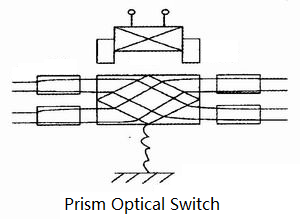
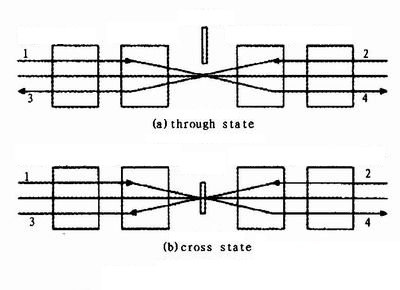
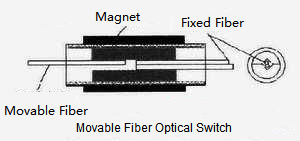
The advantages of mechanical optical switches include low insertion loss (<1 dB), high isolation (>45 dB), and insensitivity to wavelength and polarization. The manufacturing technology for these switches is well-established. However, they have several drawbacks: the switching time is relatively long (on the order of milliseconds), they are bulky, and it is challenging to create large-scale optical switch matrices with them. Additionally, there can be issues with back bounce, jitter, and poor repeatability. While mechanical optical switches have seen widespread use in recent years, as optical network scales continue to expand, these switches are increasingly unable to meet the demands of future high-speed, large-capacity optical transport networks.
MEMS Optical Switch
In recent years, micro-electro-mechanical optical switches have developed rapidly. These switches combine semiconductor microfabrication technology with micro-optics and micro-mechanics, resulting in a new type of integrated micro-electro-optical switch. They represent the mainstream direction for the development of large-capacity switching in optical networks.MEMS (Micro Electro-Mechanical System) optical switches are made by etching several tiny mirrors onto a silicon wafer. These movable micromirrors can rise, rotate, or move under the influence of electrostatic or electromagnetic forces, thereby changing the propagation direction of the input light to achieve the function of switching optical paths.
MEMS optical switches have significant advantages over other types of optical switches: the switching time is generally on the order of a few milliseconds; they use IC manufacturing technology, making them small in size and highly integrated; and their operation is independent of the format, protocol, wavelength, transmission direction, polarization direction, or modulation mode of the optical signal, allowing them to handle optical signals of any wavelength. Additionally, they combine the low insertion loss, low crosstalk, low polarization sensitivity, and high extinction ratio of mechanical optical switches with the high switching speed, small size, and ease of large-scale integration of waveguide switches.
Based on functional implementation methods, MEMS optical switches can be divided into light path blocking type, movable fiber docking type, and micromirror reflection type. Micromirror reflection type MEMS optical switches are convenient for integration and control, making them suitable for forming optical switch arrays. These switches are a key focus of MEMS optical switch research and can be further classified into two-dimensional (2D) MEMS optical switches and three-dimensional (3D) MEMS optical switches. The concept of one-dimensional (1D) MEMS optical switches has also been proposed.
The so-called 2D MEMS optical switch refers to a configuration where the movable micromirrors and optical fibers are located in the same plane, and each movable micromirror is either in an on-state or an off-state at any given time. In this setup, the movable micromirror array is connected to N input fibers and N output fibers. For an NxN optical switch matrix, the required number of movable micromirrors is N². Therefore, this method is also known as the N² configuration scheme. For example, a 4x4 2D optical switch has 16 movable micromirrors, and four 4x4 optical switches can be combined to form an 8x8 optical switch, which would contain 64 movable micromirrors.
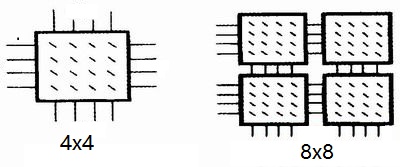
The mirror-based 2D MEMS devices consist of a two-dimensional micromirror array controlled by electrostatic forces and mounted on a mechanical base. The typical size is about 10 cm. A collimated beam and rotating micromirrors form a multi-port optical switch. The spatial fine-tuning rotating mirrors of the 2D MEMS are monolithically integrated on a silicon substrate using surface micromachining technology. The collimated light is directed to the appropriate output port by the proper rotation of the micromirrors. Micro hinges attach the micromirrors to the silicon substrate, with two push rods on either side of the micromirror. One end of the push rod is connected to the hinge point of the micromirror, and the other end is connected to the hinge point of a translating disk. The switching state is adjusted by the SDA (Scratch Drive Actuator) regulator, which adjusts the translating disk to rotate the micromirror. When the micromirror is horizontal, it allows the light beam to pass through it. When the micromirror rotates to a position perpendicular to the silicon substrate, it reflects the incident light beam onto its surface, directing the light beam to the corresponding output port of the micromirror.
The working principle of a three-dimensional Micro Electro-Mechanical Systems (MEMS) optical switch is illustrated in Figure 7, which shows the optical path diagram of a 4x4 optical switch. The primary advantage of this configuration is its simplicity in control. The main component of the control system is a transistor-transistor logic (TTL) driver, supplemented by a level-shifting circuit. This setup can provide the necessary voltage levels for each micromirror to function properly.
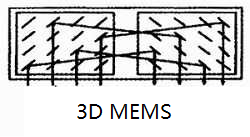
In three-dimensional MEMS optical switches, the mirrors can deflect in any direction. These arrays typically appear in pairs: the input light beam reflects off the mirrors in the first array to the mirrors in the second array, and then the light is directed to the output port. The position of the mirrors must be controlled with extreme precision, achieving an accuracy of up to one-millionth of a degree. Three-dimensional MEMS arrays could be the right choice for large-scale cross-connects, especially when wavelength bands are switched from one fiber to another.
Three-dimensional MEMS optical switches primarily use two N-mirror arrays to connect the light paths between two fiber arrays, with each micromirror having multiple possible positions. Since MEMS optical switches rely on mirror rotation to achieve switching, any mechanical friction, wear, or vibration could potentially damage the optical switch.
Although two-dimensional and three-dimensional MEMS optical switches have already been commercialized, they still face several challenges. The manufacturing process for MEMS, which involves micromirrors, must meet high precision requirements. The integrity of the structure and the flexibility of the micromirrors' rotation must be maintained even after millions or tens of millions of switch cycles to ensure the stability and continuity of optical network information transmission. MEMS optical switches must also meet mass production requirements, which demands high process stability. Additionally, the packaging and automated installation processes for MEMS, as they interact with end users, are crucial considerations.
Despite these challenges, MEMS optical switches are preferred because they combine the low loss, low crosstalk, polarization insensitivity, and high extinction ratio of conventional mechanical optical switches with the fast switching speed, compact size, and ease of large-scale integration of waveguide switches. For future backbone optical networks or large-capacity service switching applications, solutions based on MEMS optical switch technology have become a mainstream choice.
Technical Assessment Indicators of Optical Switches
The performance of optical switches is determined by factors such as traffic volume, operating conditions, and environmental factors. The requirements for optical switches are: on one hand, they must exhibit good performance in terms of insertion loss, crosstalk, extinction ratio, switching speed, switching scale, and switch size; on the other hand, they must be capable of being integrated into large-scale switch arrays to meet the demands of modern networks.
Optical switches are generally uated using the following key parameters:
Size: The size of the switching matrix reflects the switching capacity of the optical switch. The requirements for the switching matrix size vary depending on the network position of the optical switch. With the rapid growth in communication demands, the switching capacity of optical switches needs to be significantly increased, such as having more than 1000x1000 switching capacity in backbone networks. For large switching capacities, multiple smaller optical switches can be combined to form a larger switch.
Switching Speed: Switching speed is a crucial performance metric for optical switches. There are two important time scales for switching speed. When the switching time from one port to another reaches several milliseconds, it is usually sufficient for rerouting due to failures. For synchronous digital hierarchy (SDH) / synchronous optical network (SONET), a switching time of 50 milliseconds is nearly imperceptible at the upper layers when rerouting due to failures. When switching time reaches the nanosecond range, it can support packet switching in optical Internet. This is crucial for achieving the functionality of the optical Internet.
Loss: When optical signals pass through an optical switch, energy loss is inevitable. The impact of optical switches and their cascades on network performance is significant when designing the network based on power budgets. Loss and interference affect power budgeting. There are primarily two causes of optical switch loss: loss due to coupling between optical fibers and optical switch ports, and loss due to the optical switch material itself. Generally, optical switches using free-space switching have lower loss compared to those using waveguide switching. For example, liquid crystal and MEMS optical switches typically have lower loss, around 1 to 2 dB. In contrast, lithium niobate and solid-state optical switches have higher loss, approximately 4 dB. Loss characteristics affect the cascading of optical switches and limit their scalability.
Switching Granularity: Different optical network services have varying demands for switching and granularity used within the optical domain. Switching granularity can be categorized into three types: wavelength switching, wavelength group switching, and fiber switching. Switching granularity reflects the flexibility of the optical switch in handling services. This is crucial for accommodating various network service needs, as well as for network protection and restoration.
Blocking Characteristics: Blocking characteristics refer to the ability of an optical switch to route any input signal to any output port at any given time. The blocking characteristics become more pronounced in large or cascaded optical switches. Optical switches are required to have strict non-blocking characteristics.
Scalability: The scalability of optical switches varies based on different principles and technologies. Some technologies allow operators to increase the switch capacity as needed. Many switch structures can be easily upgraded to 8x8 or 32x32 configurations but may not scale to hundreds or thousands of ports, limiting their use to constructing OADMs (Optical Add-Drop Multiplexers) or OXCs (Optical Cross-Connects) for metropolitan networks rather than backbone networks.
Reliability: Optical switches need to exhibit good stability and reliability. In certain extreme cases, optical switches may need to perform thousands or even tens of thousands of frequent operations. In some scenarios, such as protection switching, the number of switch operations may be minimal, and maintaining the state of the optical switch becomes more crucial. For instance, with inkjet bubble optical switches, maintaining the bubble state is an important consideration.
Many factors influence the performance of optical switches, including crosstalk between switches, isolation, and extinction ratio, all of which are critical to network performance. When optical switches are cascaded, these parameters significantly impact the network's performance. Optical switches are required to be transparent to rate and service types. When constructing absolutely non-blocking large optical switch matrices, reducing crosstalk, minimizing loss, and achieving low cost are key research areas.
Optical switch technology is rapidly evolving, with several trends worth noting. As traffic demands surge, the switching capacity of backbone networks also increases, necessitating the continuous expansion of optical switch matrix sizes. Additionally, the explosive growth of IP services requires future optical transport networks to support optical packet switching, and future core routers will need to perform switching at the optical layer. This places higher demands on the switching speed of optical switches (in the nanosecond range).
Thermo-optic switch arrays and micro-mechanical switch arrays, due to their high level of integration, are expected to be the direction for large-scale array optical switches. MEMS optical switches currently show the most promise and are best suited to meet the requirements of DWDM (Dense Wavelength Division Multiplexing) all-optical communication networks. With the advantages of strong compatibility, ease of integration, design flexibility, and large-scale production capabilities, the integration and industrialization of MEMS optical switches will be a key focus for their future development. Traditional mechanical optical switches have substantial market potential in optical signal monitoring applications. In summary, high-capacity, high-speed, transparent, and low-loss optical switches will play increasingly important roles in the development of optical networks.



















